
An electronic calculator is typically a portable electronic device used to perform calculations, ranging from basic arithmetic to complex mathematics.
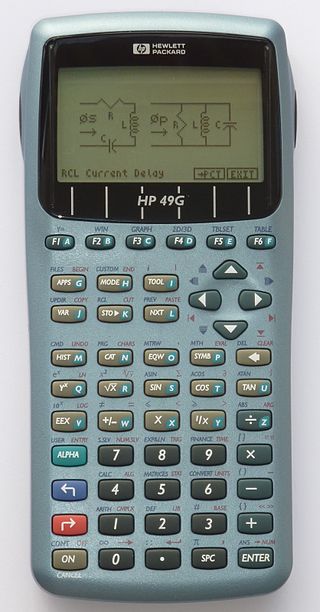
The HP 49/50 series are Hewlett-Packard (HP) manufactured graphing calculators. They are the successors of the HP 48 series.

A scientific calculator is an electronic calculator, either desktop or handheld, designed to perform calculations using basic and complex mathematical operations and functions. They have completely replaced slide rules as well as books of mathematical tables and are used in both educational and professional settings.
4-bit computing is the use of computer architectures in which integers and other data units are 4 bits wide. 4-bit central processing unit (CPU) and arithmetic logic unit (ALU) architectures are those that are based on registers or data buses of that size. A group of four bits is also called a nibble and has 24 = 16 possible values, with a range of 0 to 15.

The HP 33s (F2216A) was a scientific calculator marketed by Hewlett-Packard. It was introduced in 2003 as the successor to the HP 32SII, and discontinued on the introduction of its successor the HP 35s in 2007.
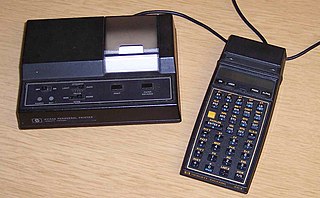
The HP-41C series are programmable, expandable, continuous memory handheld RPN calculators made by Hewlett-Packard from 1979 to 1990. The original model, HP-41C, was the first of its kind to offer alphanumeric display capabilities. Later came the HP-41CV and HP-41CX, offering more memory and functionality.

The HP-42S RPN Scientific is a programmable RPN Scientific hand held calculator introduced by Hewlett-Packard in 1988.

The HP-27S was a pocket calculator produced by Hewlett-Packard, introduced in 1988, and discontinued between 1990 and 1993. It was the first HP scientific calculator to use algebraic entry instead of RPN, and though it was labelled scientific, it also included features associated with specialized business calculators.
Engineering notation or engineering form (also technical notation) is a version of scientific notation in which the exponent of ten is always selected to be divisible by three to match the common metric prefixes, i.e. scientific notation that aligns with powers of a thousand, for example, 531×103 instead of 5.31×105 (but on calculator displays written without the ×10 to save space). As an alternative to writing powers of 10, SI prefixes can be used, which also usually provide steps of a factor of a thousand. On most calculators, engineering notation is called "ENG" mode as scientific notation is denoted SCI.

The HP-12C is a financial calculator made by Hewlett-Packard (HP) and its successor HP Inc. as part of the HP Voyager series, introduced in 1981. It is HP's longest and best-selling product and is considered the de facto standard among financial professionals. There have been multiple revisions over the years, with newer revisions moving to an ARM processor running a software emulator of the original Nut processor. Critics claim that its 1980s technology is antiquated, but proponents point out that it is still the de facto and de jure in high finance.
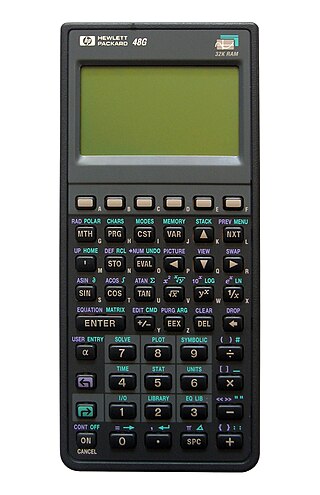
HP calculators are various calculators manufactured by the Hewlett-Packard company over the years.
Programmable calculators are calculators that can automatically carry out a sequence of operations under control of a stored program. Most are Turing complete, and, as such, are theoretically general-purpose computers. However, their user interfaces and programming environments are specifically tailored to make performing small-scale numerical computations convenient, rather than general-purpose use.

The Hewlett-Packard Voyager series of calculators were introduced by Hewlett-Packard in 1981. All members of this series are programmable, use Reverse Polish Notation, and feature continuous memory. Nearly identical in appearance, each model provided different capabilities and was aimed at different user markets.
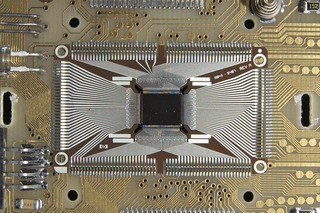
The Saturn family of 4-bit (datapath) microprocessors was developed by Hewlett-Packard in the 1980s first for the HP-71B handheld computer, released in 1984, and later for various HP calculators. It succeeded the Nut family of processors used in earlier calculators. The HP48SX and HP48S were the last models to use HP manufactured Saturn processors, later models used processors manufactured by NEC. The HP 49 series initially used the Saturn CPU until the NEC fab could no longer manufacture the processor for technical reasons in 2003. Starting with the HP 49g+ model in 2003, the calculators switched to a Samsung S3C2410 processor with an ARM920T core which ran an emulator of the Saturn hardware in software. In 2000, the HP 39G and HP 40G were the last calculators introduced based on the actual NEC fabricated Saturn hardware. The last calculators introduced to use the Saturn emulator were the HP 39gs, HP 40gs and HP 50g in 2006, as well as the 2007 revision of the hp 48gII. The HP 50g was the last calculator sold by HP using this emulator when it was discontinued in 2015 due to Samsung stopping production of the ARM processor on which it was based.

The HP-15C is a high-end scientific programmable calculator of Hewlett-Packard's Voyager series produced between 1982 and 1989.

The HP-34C continuous memory calculator is an advanced scientific programmable calculator of the HP 30 series. It was produced between 1979 and 1983.

The HP 35s (F2215A) is a Hewlett-Packard non-graphing programmable scientific calculator. Although it is a successor to the HP 33s, it was introduced to commemorate the 35th anniversary of the HP-35, Hewlett-Packard's first pocket calculator. HP also released a limited production anniversary edition with shiny black overlay and engraving "Celebrating 35 years".
A graphing calculator is a class of hand-held calculator that is capable of plotting graphs and solving complex functions. While there are several companies that manufacture models of graphing calculators, Hewlett-Packard is a major manufacturer.

The FX-501P and FX-502P were programmable calculators, manufactured by Casio from 1978/1979. They were the predecessors of the FX-601P and FX-602P.
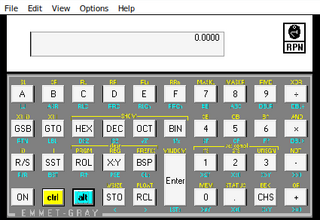
WRPN is a public domain open-source scientific software calculator, simulating the Hewlett-Packard Voyager series' HP-16C "Computer Scientist" programmable calculator.
















